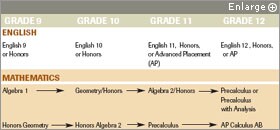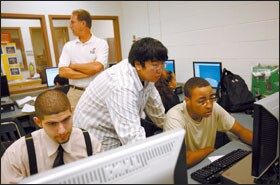Amid the clicking of computer mice and muted consultation, Wheaton High School teacher Marcus Lee’s class of 11th and 12th graders pored over the electronic blueprint for a four-story building they were designing on their desktops. The calculations for each floor needed to be set just right if the structure was to stand on its own.
“What we want to do is lay a foundation,” Mr. Lee explained. He was addressing the students in his civil-engineering and architecture class, but he could just as well have been talking about the goal of his school’s Academy of Engineering—and that of , the national curriculum it uses.
| A Search for Answers in Science and Math |
|---|
Often referred to by its acronym, PLTW is a rigorous four-year program of honors-level math and science, plus engineering, culminating in at least precalculus and advanced science classes, along with an intensive, hands-on collaborative engineering project. The curriculum is produced by Project Lead the Way Inc., a 10-year-old, Clifton Park, N.Y.-based nonprofit organization dedicated to increasing the number of American college students who study and ultimately work in engineering fields.
The program has swiftly grown to include about 2,200 schools in 49 states. Last school year, 175,000 students were enrolled in PLTW classes nationwide.
Shane R. Stroup, the director of Wheaton High’s Academy of Engineering, gives the rigor of PLTW’s curriculum much of the credit for the success his students have had so far.
Members of the academy’s 26-student class of 2007—its first graduating class—went on to study in mechanical, electrical, nuclear, and other engineering fields at such selective universities as the Massachusetts Institute of Technology and Cornell University, claiming more than $1.6 million in scholarships. Eighty-nine percent of Wheaton High’s 1,325 students are members of racial or ethnic minorities, and 41 percent receive free or reduced-price lunches.
“I think the reason was because of the Project Lead the Way curriculum,” said Mr. Stroup. “It prepared these students.”
It’s a familiar refrain that the United States is critically short of students prepared to perpetuate the nation’s decades-long pre-eminence in science, engineering, and the mathematics critical to both.
But when it comes to doing something about it, educators who have studied the alternatives say there’s no one else offering as much rigor in the so-called STEM fields of science, technology, engineering, and math education to as many students as Project Lead the Way.
“What we found was that PLTW offers the best curriculum out there,” said Bart Aslin, the director of the Society of Manufacturing Engineers 91��Ƭ����Ƶ Foundation in Dearborn, Mich. “It’s a pipeline vision to let as many students as possible see the excitement of science, technology, math.”
Students at the Project Lead the Way program at Wheaton High School in Montgomery County, Md., can choose from among several sequences of courses designed to prepare them for the postsecondary study of engineering.
Click on graphic below to see the Grade 9 - 12 curriculum.

NOTE: The curriculum also calls for freshmen and sophomores to take physical education, and for seniors to take an engineering-related college course, elective, or internship.
SOURCE: Montgomery County (Md.) Public Schools
PLTW was singled out by the congressionally chartered National Academy of Sciences in its oft-cited which recommended that the program serve as the national model for expansion of science and engineering education.
Still, the program is neither cost-free nor easy. Because of the hands-on nature of many PLTW classes, implementing the curriculum can cost up to $95,000 per school depending on what computer equipment and facilities a school already has. Robotic equipment and automated manufacturing machinery required for PLTW elective courses, such as Computer Integrated Manufacturing, can cost tens of thousands of dollars more.
Schools or districts must also pay for the specialized two-week summer training for teachers at one of PLTW’s 30-plus partner colleges and universities. The per-teacher cost of the required course varies, but can exceed $2,000.
To the teachers who attend—70 percent of whom have previously taught career and technical education, and may not have any formal engineering training—the cost may feel like the least of it. Mr. Stroup, the Wheaton High engineering-academy director, called the training “boot camp.”
“These classes are very hard-hitting,” concurred Renny Whittenbarger, an engineering teacher at Cleveland High School in Cleveland, Tenn. “PLTW will fail you. … You have to pass their exam before they let you [teach].”
At Wheaton High School, a clutch of adults filtered into Mr. Lee’s darkened class early one recent Monday morning, watching as the students compared notes on their building project. The students were showcasing the kind of collaborative effort that PLTW emphasizes, in lieu of the “eyes on your own paper” style of learning that prevails in many classrooms.
“What’s really impressive to me is to see the kids helping each other out—you never see that at the university level,” whispered James W. Sturges. “That’s how we work in engineering.”
Mr. Sturges was visiting in part because he’s the president of the Montgomery County school district’s advisory board on careers in engineering, scientific research, and manufacturing technologies, but also because he is the director of mission assurance at the Bethesda, Md.-based aerospace giant Lockheed Martin Corp.
“We’re the biggest employer of engineers in the United States,” said Mr. Sturges, who is himself an engineer. “If we can’t get [enough of] those, it’s going to affect our business.”

Those same concerns gave rise to the project that would become PLTW.
In the 1980s, Richard Blaise, now a vice president of PLTW, was the director of occupational education for the Shenendehowa Central School District in Clifton Park, N.Y. To help expand his district’s technology education offerings, he reached out to local industry leaders, including Richard C. Liebich, now PLTW’s chief executive officer and the chairman of its board of directors, to form a technology advisory board.
Mr. Liebich, a former president of Houston-based Sysco Foods, was then running Transport National Development, an industrial cutting-tool manufacturer in Orchard Park, N.Y.—one of several similar companies he would eventually head as CEO and chairman.
Mr. Liebich was having trouble hiring engineers, “and it became apparent then that, yes, we need to do something,” said PLTW spokeswoman Crickett Thomas-O’Dell.
Funding the nascent idea through Mr. Liebich’s Clifton Park-based Charitable Venture Foundation, Mr. Blaise and his staff were able to field-test what would become PLTW at upstate New York middle schools in the late 1980s and early 1990s. By the 1997-98 school year, when PLTW was spun off to become a separate nonprofit group, high schools piloted the program, and by 2000-01, over 300 schools in more than 25 states offered the curriculum.
Project Lead the Way is now self-sufficient, running on revenues from the licensing of PLTW software and the sale of teaching tools to schools, Ms. Thomas-O’Dell said.
David Waugh, a dean emeritus of the University of South Carolina’s college of engineering who has observed PLTW with interest but is not involved with the program, attributes much of its rapid expansion to the fact that while many precollegiate educators recognize the importance of engineering, few teach the subject.
“So many people in high school have very little idea about what engineering really is,” said Mr. Waugh, a past president of the Alexandria, Va.-based National Society of Professional Engineers. “They have science classes, and they’ll encounter things like chemistry and even physics, but with engineering, they don’t encounter anything. That’s sort of where it ends.”
By contrast, PLTW puts engineering firmly in the foreground, and it mixes lots of projects into the curriculum.

“We make it fast-paced and hands-on,” said Steve Clariday, the career education director at Cleveland High in Tennessee.
As part of a Cleveland High PLTW engineering class, students work in teams to build cardboard boats that they’ll race in the school’s swimming pool. But first they have to calculate how many cubic feet the boat should be, how fast it will sink, and other factors on their own; the only equation they’re given is that one cubic foot of cardboard will sustain 60 pounds.
“They get frustrated,” Mr. Clariday said, “but they get to know the math.”
Cleveland High students also have designed tools to help people in their community, including a can opener with an extra mechanical advantage to help a woman with arthritis, and a rake that a one-armed man can use comfortably.
Along with other nations’ more-aggressive prioritization of technical education, raw population trends do not favor future American pre-eminence in engineering.
According to projections by the Paris-based Organization for Economic Cooperation and Development’s directorate for education, India will produce more than twice the number of American and European college graduates combined by 2015. China will have even more.
The United States “cannot build a workforce of just white males in engineering,” said Laurie Maxson, the director of Science Technology & Engineering Preview Summer Camp Academy in Colorado Springs, Colo.—a transition between PLTW’s middle-school-level Gateway to Technology program and its high school curriculum.
“They’re focusing on all groups—all groups in this country are underrepresented when it comes to engineering,” the University of South Carolina’s Mr. Waugh said of PTLW.
According to by the evaluation firm TrueOutcomes Inc. of York, Pa., the program has had some success in recruiting students of color.
White students still account for more than 70 percent of PLTW students. But they’re only slightly overrepresented in PLTW classes compared with the enrollment of the schools in which they operate. Hispanics also are slightly overrepresented in PLTW classes, relative to the populations of their schools.
African-Americans are underrepresented by about 20 percentage points in PLTW classes, compared with their share of their schools’ overall enrollment—“not where we want to be,” said Carolyn Helm, PLTW’S pre-engineering curriculum project director.
“But we’re doing a heck of a lot better than colleges,” in whose engineering programs African-Amerian students are even more underrepresented, she said.
The program has had trouble attracting girls, who make up only 17 percent of PLTW classes. “We really have a hard time getting females involved,” Ms. Maxson said.
Yet Project Lead the Way has made strong inroads among two other groups that are not always well represented in STEM fields: the less-well-off and the academically unspectacular.

According to the TrueOutcomes data, the program is available at schools across the economic spectrum, but is represented especially well at schools that serve free or reduced-price lunches to more than 70 percent of their students.
“We don’t have money for college,” said Jessica Steinmann, a 16-year-old senior in Wheaton High’s engineering academy. “This is a way out.”
A Haitian immigrant, Ms. Steinmann now plans to study aeronautical engineering in college.
Andrew Kim, a 17-year-old Korean-American senior in the Academy of Engineering, came into the program in 9th grade as a special education student with poor grades. Now he is breezing through honors-level classes and hopes to study mechanical engineering at either MIT or the University of Maryland Baltimore County.
“My dad actually didn’t want me to go to Wheaton High School,” said Mr. Kim, recalling his father’s fears about “thugs in the hallways.” The school is the poorest in mostly affluent Montgomery County, Principal Kevin E. Lowndes said.

But Mr. Kim said the academy’s rigor has won his father over, and now his younger brother, a 9th grader, has joined the program.
If PLTW hewed to the usual strategy of putting high-rigor academic programs only in well-to-do areas, said Mr. Sturges, the Lockheed engineer and advisory-board president, “you wouldn’t put this [engineering academy] in a high-FARMS [free and reduced-price meal system] area, you’d put it in a no-FARMS area.”
Mr. Lowndes, the Wheaton High principal, said “the most impressive thing” about the engineering program is what it does for average students. “It’s teaching them through a cohort how to be successful in school and why it’s important to take the rigorous courses,” he said.
As Lynne M. Gilli, the program manager of the Maryland Department of 91��Ƭ����Ƶ’s career and technical education instructional branch, put it: “We are not trying to recruit the best and brightest” for PLTW pre-engineering programs. “We’re trying to recruit the top 80 percent.”




